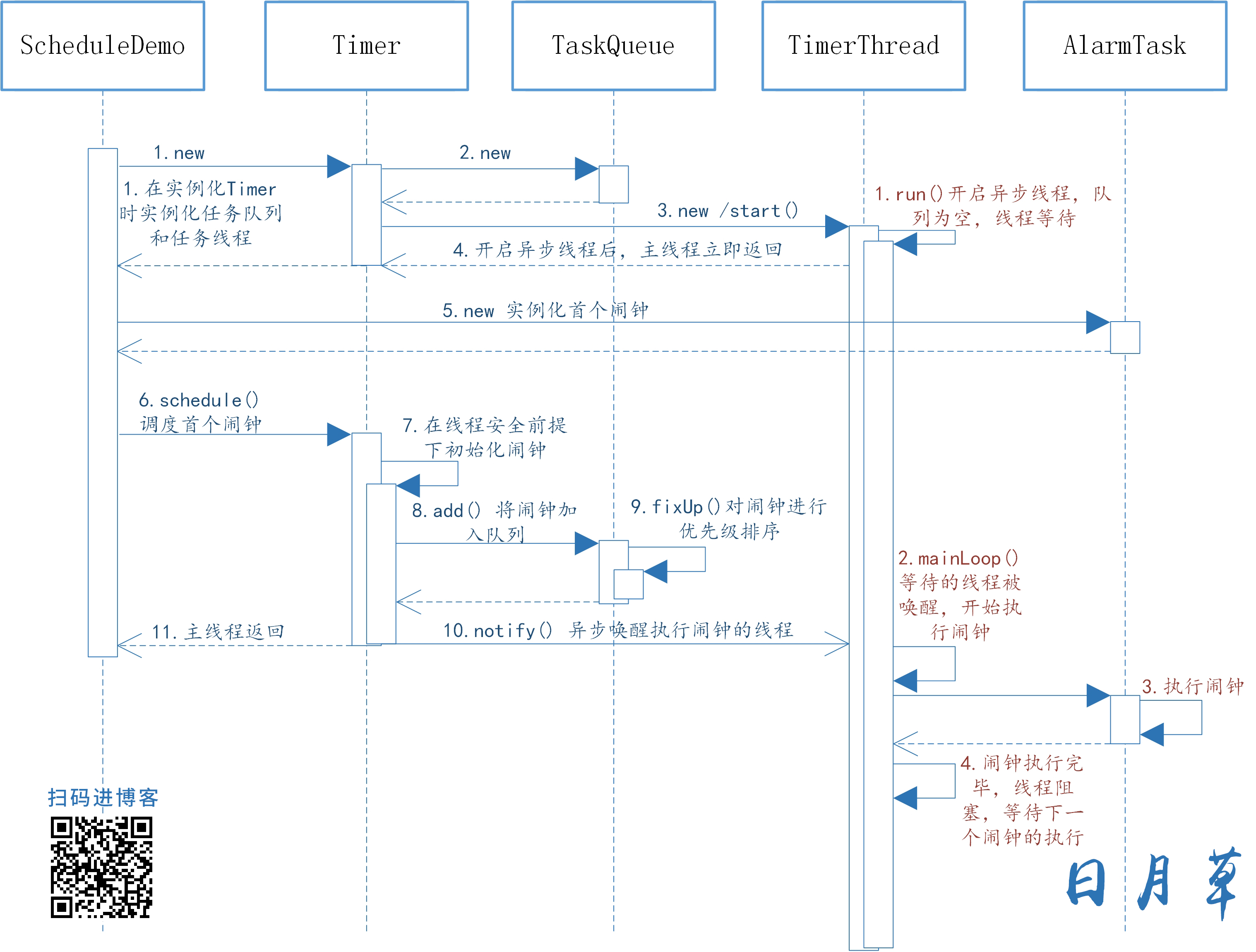就以闹钟的例子开头吧(后续小节皆以闹钟为例,所有源代码只列关键部分)。
public class ScheduleDemo {
public static void main(String[] args) throws InterruptedException {
long delay = 1000; // 一秒后开始执行
long period = 2000; // 执行间隔
Timer timer = new Timer();
AlarmTask alarm = new AlarmTask("闹钟1");
log.info("["+Thread.currentThread().getName()+"]开启闹钟调度!");
timer.schedule(alarm,delay,period);
}
/**
* 模拟闹钟
*/
static class AlarmTask extends TimerTask{
String name ;
public AlarmTask(String name){
this.name=name;
}
@Override
public void run() {
log.info("["+Thread.currentThread().getName()+"]"+name+":嘀。。。");
Thread.sleep(1000); //模拟闹钟执行时间,省略异常。。。
}
}
}
一秒以后闹钟每隔两秒执行一次。
[main] 开启闹钟调度!
[Timer-0] 闹钟1:嘀。。。
[Timer-0] 闹钟1:嘀。。。
[Timer-0] 闹钟1:嘀。。。从打印结果可以看到,闹钟调度与执行并非一线程。
下面是Timer时序图,可以了解Timer的大概流程。
下面开始分析Timer源码。
public class Timer {
private final TaskQueue queue = new TaskQueue();
private final TimerThread thread = new TimerThread(queue);
public Timer() {
this("Timer-" + serialNumber());
}
public Timer(String name) {
thread.setName(name);
thread.start();
}
可以看到,Timer中维护了一个内部线程与队列,且在实例化Timer的同时,就已初始化好了。在初始化Timer时,内部线程TimerThread开始启动,下面是TimerThread的执行过程。
class TimerThread extends Thread {
public void run() {
mainLoop();
}
private void mainLoop() {
while (true) {
synchronized(queue) {
// 队列为空,线程被阻塞
while (queue.isEmpty() && newTasksMayBeScheduled)
queue.wait();
可以看到,虽然线程TimerThread已启动,但因队列为空,线程被阻塞(等待queue锁)。
以上是Timer timer = new Timer()的整个运行过程,继续看timer.schedule(alarm,delay,period)。
public class Timer {
public void schedule(TimerTask task, long delay, long period) {
sched(task, System.currentTimeMillis()+delay, -period);
}
private void sched(TimerTask task, long time, long period) {
synchronized(queue) {
synchronized(task.lock) {
task.nextExecutionTime = time;
task.period = period;
task.state = TimerTask.SCHEDULED;
}
// 将闹钟加入队列
queue.add(task);
// 此时正好满足条件,主线程释放queue锁,并唤醒TimerThread
if (queue.getMin() == task)
queue.notify();
}
}
从源码可看出,主线程正好满足queue.getMin() == task,此时将唤醒TimerThread线程(waiting)并释放queue锁。
下面再切换到TimerThread的运行场景。
private void mainLoop() {
while (true) {
synchronized(queue) {
while (queue.isEmpty() && newTasksMayBeScheduled)
queue.wait();
if (queue.isEmpty())
break;
task = queue.getMin();
synchronized(task.lock) {
currentTime = System.currentTimeMillis();
executionTime = task.nextExecutionTime;
// 已经到了执行时间
if (taskFired = (executionTime<=currentTime)) {
// ...重新定义下次闹钟执行时间
}
}
if (!taskFired)
// 执行时间未到,线程再次阻塞
queue.wait(executionTime - currentTime);
}
if (taskFired)
task.run(); // 同步执行用户定义的闹钟
}
}
通过上面的源码分析,TimerThread被唤醒后,将判断执行时间,时间到则初始化下次闹钟的执行时间并运行本次闹钟,否则线程将等待指定时间。
如此周而复始。。